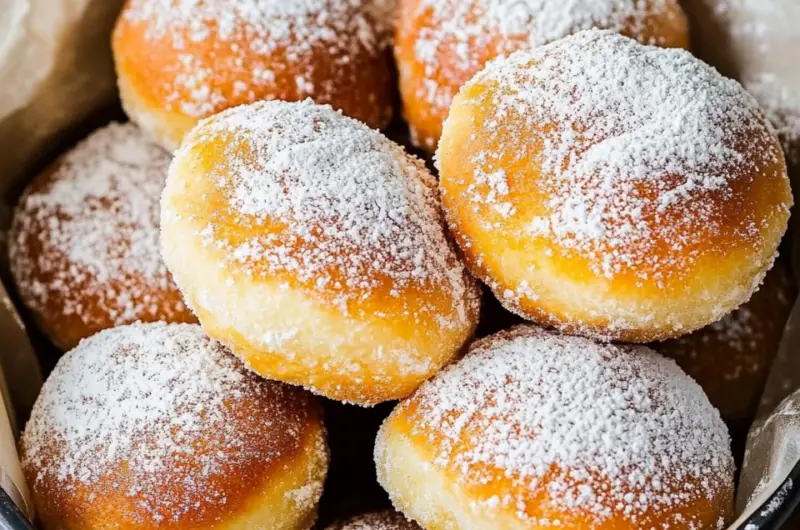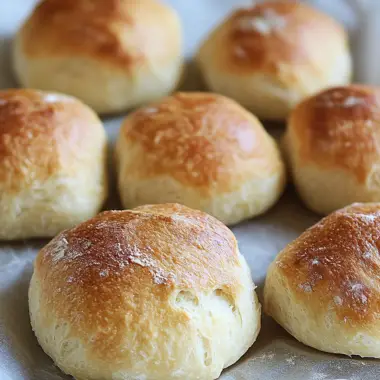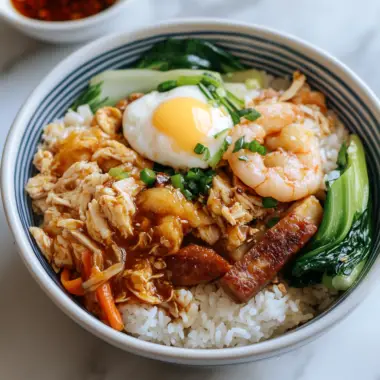The malasada, a beloved Hawaiian treat with Portuguese roots, is the epitome of indulgence. These deep-fried dough balls are a celebration of simplicity and flavor crispy on the outside, warm and pillowy within, and generously rolled in a blanket of sugar. Traditionally made for Fat Tuesday celebrations (Malasada Day) in Hawaii, they’ve gained fame far beyond the islands as the ultimate sweet snack. Whether enjoyed plain or filled with custard, chocolate, or tropical creams, malasadas offer endless versatility. Their fluffy texture and golden crust make them irresistible right out of the fryer. This recipe brings authentic malasadas straight into your kitchen no tropical vacation required. Perfect for weekend brunches, family gatherings, or satisfying your donut cravings, these treats are guaranteed to impress anyone lucky enough to snag one fresh.
Full Recipe:
Ingredients:
-
1 tablespoon active dry yeast
-
1 teaspoon sugar
-
1/4 cup warm water
-
6 large eggs
-
1/2 cup unsalted butter, melted
-
1/2 cup sugar
-
1 cup evaporated milk
-
1 teaspoon vanilla extract
-
1/2 teaspoon salt
-
5 1/2 to 6 cups all-purpose flour
-
Vegetable oil, for frying
-
Granulated sugar, for coating
Directions:
-
In a small bowl, dissolve the yeast and 1 teaspoon of sugar in warm water. Let sit for 5–10 minutes until foamy.
-
In a large bowl, beat the eggs, then add the melted butter, sugar, evaporated milk, vanilla, and salt. Mix well.
-
Add the yeast mixture and gradually stir in the flour, one cup at a time, until a soft dough forms.
-
Knead the dough on a floured surface until smooth and elastic, about 8–10 minutes.
-
Transfer to a greased bowl, cover, and let rise in a warm place until doubled, about 1.5 to 2 hours.
-
Punch down the dough and turn it out onto a floured surface. Roll to about 1/2-inch thickness and cut into 2.5-inch squares or rounds.
-
Place cut dough on a floured baking sheet, cover loosely, and let rise again for about 30–45 minutes.
-
Heat oil in a deep fryer or large pot to 350°F (175°C). Fry malasadas in batches until golden brown, about 1–2 minutes per side.
-
Drain on paper towels and immediately toss in granulated sugar while still warm.
Prep Time: 2 hours | Cooking Time: 20 minutes | Total Time: 2 hours 20 minutes
Kcal: 270 kcal | Servings: 24 malasadas
Malasadas: Hawaii’s Beloved Portuguese Doughnuts
Malasadas are a cherished treat that bridge cultures, continents, and culinary traditions. Originally brought to Hawaii by Portuguese immigrants from Madeira and the Azores, these fried balls of dough crispy on the outside and pillowy-soft on the inside have become a treasured staple in the islands. Coated generously in granulated sugar and often served plain, malasadas are now also found filled with custard, tropical creams, or chocolate ganache, blending the traditional with the modern in delicious ways.
Whether you’re a seasoned baker or a curious food enthusiast looking to try something new, malasadas offer a satisfying combination of history, texture, and indulgence that will enrich your kitchen experience. In this article, we will explore the rich cultural background of malasadas, how they evolved into a Hawaiian icon, tips for making them at home, variations to try, and why these simple yet sumptuous doughnuts have stood the test of time.
The Cultural Roots of Malasadas
Malasadas trace their origins to Portugal, particularly the Madeira and Azores islands. The word “malasada” roughly translates to “under-cooked” or “poorly cooked,” which might sound unappealing at first, but the name refers to the soft and doughy center of this delicious fried dessert.
Portuguese immigrants brought malasadas with them when they moved to Hawaii in the late 19th and early 20th centuries to work on the sugarcane plantations. While the original recipe remained relatively unchanged, malasadas were quickly embraced by the local Hawaiian community, becoming a treat synonymous with festive occasions.
One key celebration where malasadas feature prominently is Shrove Tuesday (the day before Ash Wednesday), also known locally as “Malasada Day.” Traditionally, this was the day to use up rich ingredients like sugar, butter, and eggs before the start of Lent. Today, it remains a day where malasadas fly off bakery shelves across Hawaii.
Why Malasadas Are So Popular in Hawaii
Hawaii’s culinary landscape is a melting pot of global influences, and malasadas fit perfectly within that vibrant mix. The Portuguese doughnuts found a new identity in the islands, embraced by locals of all backgrounds. Their appeal lies in both their simplicity and their decadence a crisp golden exterior coated in sugar, giving way to a warm, airy center.
Unlike typical American doughnuts, malasadas do not have a hole in the middle. They are round, often irregularly shaped, and made from an enriched dough similar to brioche. Their light, fluffy texture sets them apart from denser fried pastries, making them an ideal vessel for both sugary coatings and creamy fillings.
The popularity of malasadas in Hawaii has led to their permanent placement on bakery menus, food trucks, and even fine dining dessert lists. From roadside stalls to iconic bakeries like Leonard’s in Honolulu, you’ll find locals and tourists alike lining up for a hot malasada fresh out of the fryer.
Tips for Making Malasadas at Home
While malasadas may look intimidating, they are surprisingly approachable with a little patience and preparation. Because they’re made from a yeast-leavened dough, allowing proper time for rising is essential. A good malasada has a light, airy interior this can only be achieved through sufficient proofing.
Kneading the dough thoroughly will develop the gluten structure needed for a fluffy interior, while frying at the right temperature (typically around 350°F or 175°C) ensures a golden-brown exterior without burning or oil absorption.
Another key tip is to toss the malasadas in granulated sugar while they are still warm, so the sugar adheres properly and forms that signature crunchy-sweet crust.
If you’re looking to fill your malasadas, make sure they cool slightly first before piping in any cream or custard. Pastry cream, coconut haupia, chocolate pudding, and even guava jam are all popular Hawaiian-inspired fillings.
Variations on the Classic Malasada
Though traditional malasadas are unfilled and simply coated in sugar, modern bakers and pastry chefs have created an array of creative twists on the original. In Hawaii, many malasadas are filled with tropical flavors like:
-
Lilikoi (Passion Fruit) Curd – Tart and vibrant, this filling adds a tropical zing.
-
Haupia (Coconut Pudding) – A smooth, creamy coconut-based custard that adds richness.
-
Chocolate or Nutella – A decadent option for chocolate lovers.
-
Custard or Bavarian Cream – A nod to the classic cream-filled doughnut, this gives the malasada a luxurious twist.
Some bakers also experiment with flavored sugar coatings, such as cinnamon sugar or even li hing mui powder (a salty-sweet plum powder that’s beloved in Hawaii).
For a lighter touch, some opt to bake malasadas instead of frying them, though purists would argue that the texture and flavor are never quite the same.
Where to Find the Best Malasadas in Hawaii
If you ever find yourself in Hawaii, experiencing a freshly made malasada is a culinary must. Perhaps the most famous malasada bakery is Leonard’s Bakery in Honolulu, which has been serving malasadas since 1952. With their pink boxes and made-to-order frying, Leonard’s has become a tourist landmark and a local favorite.
Other beloved malasada spots include Pipeline Bakeshop & Creamery, Tex Drive-In on the Big Island, and many mom-and-pop bakeries scattered across Oahu, Maui, and Kauai. Each place puts its unique spin on the classic recipe, offering both nostalgic and innovative flavors.
Why You Should Try Malasadas
Malasadas offer more than just a sweet treat they are a bite-sized window into the cultural fusion that defines Hawaiian cuisine. By making them at home, you’re not only enjoying something delicious but also connecting with a piece of food history that spans continents and generations.
For bakers, malasadas are a fun and rewarding project. The process of proofing, shaping, frying, and sugar-coating engages all your senses, and the results are visually satisfying and crowd-pleasing. You can stick to tradition or let your creativity run wild with fillings and toppings.
From weekend brunches to holiday celebrations, malasadas are sure to be a show-stopper on any table. Whether you serve them plain or stuffed, one thing is certain they’ll disappear quickly.
Conclusion:
Malasadas are more than just doughnuts they’re a legacy, a celebration, and a sweet indulgence all rolled into one. Rooted in Portuguese tradition and adopted wholeheartedly by Hawaiian culture, they tell a story of migration, adaptation, and the universal joy of sharing food.
This recipe brings that rich story into your kitchen, giving you the opportunity to create something truly special. Whether you’re making them for Malasada Day, a Sunday morning breakfast, or simply to satisfy a craving, these golden pillows of sweetness are guaranteed to leave a lasting impression.








